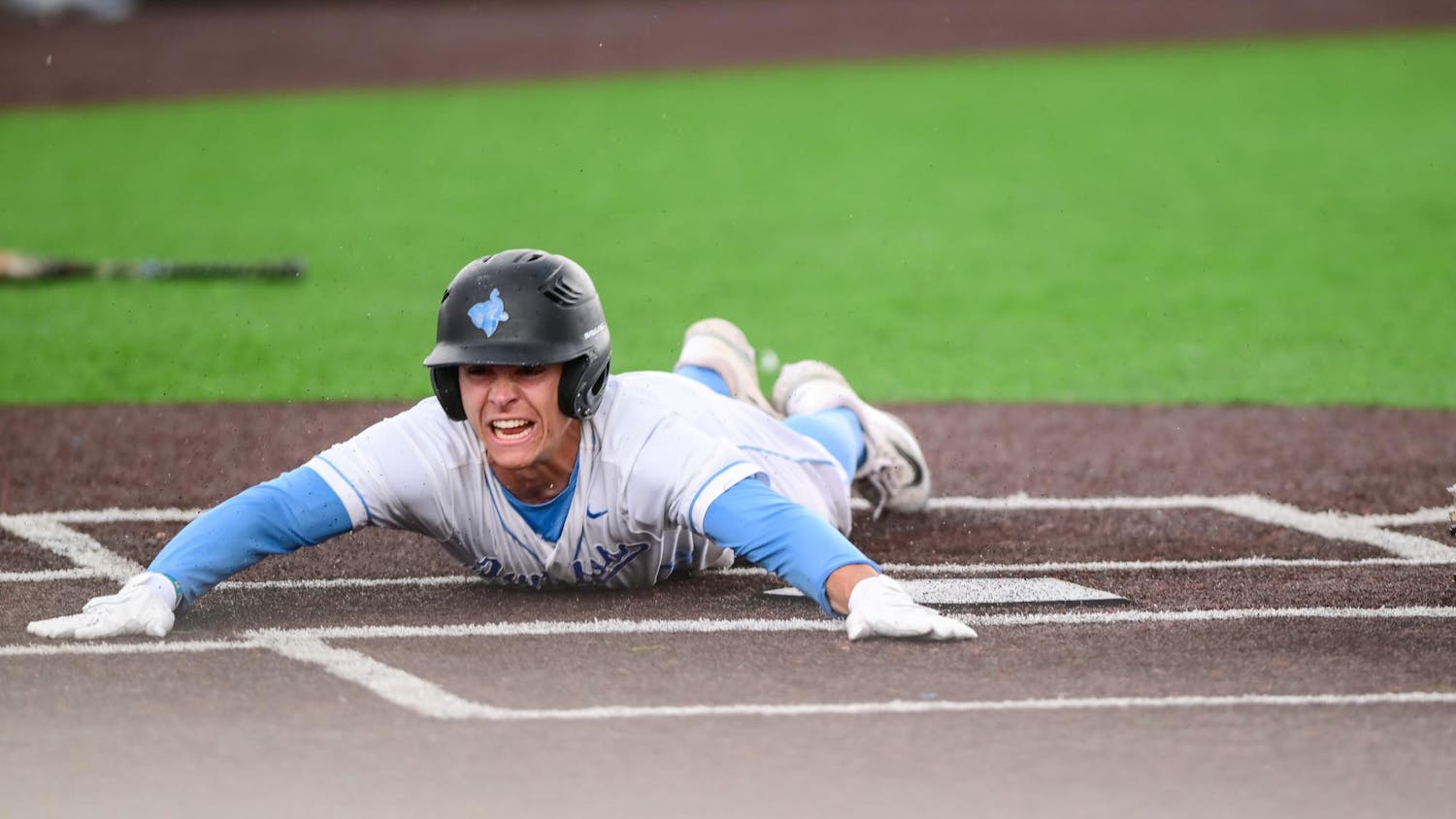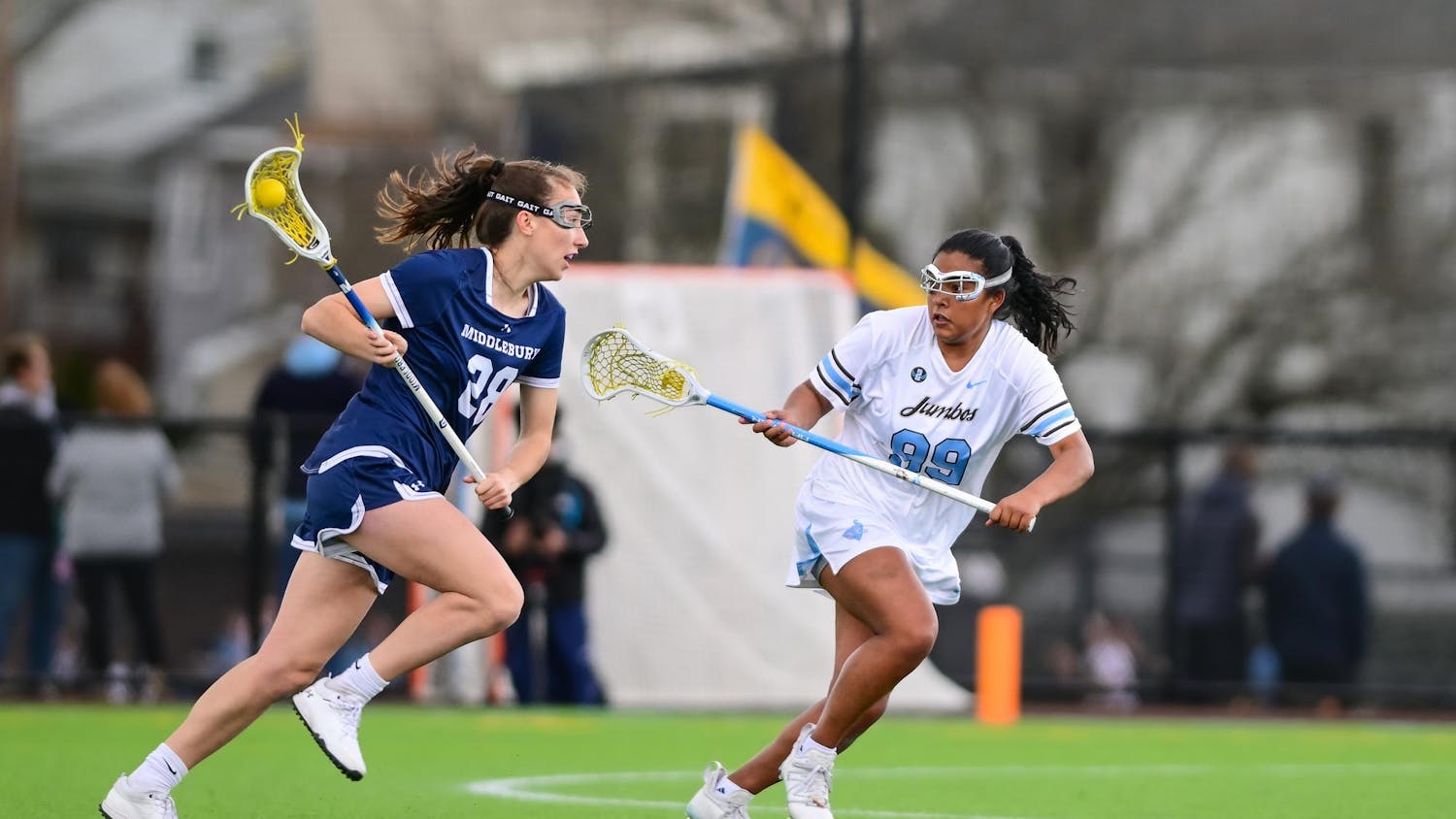With the power to lift 700,000 pounds, elephants are some of the strongest creatures on Earth. But keeping the Jumbos strong is nonetheless an elephantine endeavor.
That’s where the strength and conditioning coaches come in.
In his role as director of sports performance, Dan Kopcso oversees strength and conditioning for Tufts varsity athletes. Kopcso also manages the fitness center and teaches a physical education course, Advanced Principles of Exercise. Alongside Assistant Strength and Conditioning Coach Marten Vandervelde and Strength and Conditioning Assistant Alex O’Keefe, as well as a team of several undergraduate and graduate interns, Kopcso works with Jumbos in the weight room throughout the year to ensure they stay healthy for the entirety of their season.
“Our number one goal across the [board] is injury prevention: How do we eliminate or minimize these injuries, whether it’s based on that sport, the type of person we’re talking about or the individual themselves?” Kopcso said.
Kopsco said performance enhancement was second to the goal of injury prevention.
“I would argue that everybody does the physical side of things. The big thing we also try to do is spend a lot of time on the psychological side — teamwork, competitiveness, putting people in mental environments that are challenging for them, often times having them take a leadership role as a [first-years] and having them make a lot of mistakes and suck at it and get better,” he said.
For Vandervelde, one of the two assistant trainers on staff, the role of the strength and conditioning coach manifests itself beyond just lifting weights and training.
“The misnomer is that everyone thinks we’re here to make people stronger and faster,” Vandervelde said. “Can we keep people healthy by convincing them to sleep more hours, drink more water, eat better foods and things like that? Even if they’re working out a lot — let’s say three hours a day, so 21 a week — that’s 21 hours out of 168. Life outside the gym is much more important.”
Each team is assigned to a strength and conditioning coach — either Kopcso, Vandervelde, or O’Keefe — who works primarily with that team, writing and administering sport-specific workout plans. The interns assist in the implementation of the programs, and by the end of the academic year, the graduate interns also write their own programs for the teams.
Most teams have scheduled team lift times in season during which athletes are required to work out in the weight room. In the offseason, depending on the sport, training programs are more flexible, and athletes can work out when they want and sometimes follow more individualized programs.
“In season, it’s definitely more of a team-based program — that’s the time when we’ll bring a team and have a set ‘This is what you should do,'” Kopcso said. “But, any time there [are] injuries, individual differences [or] positional differences, there’s a lot of juggling those things. Throughout the year, athletes come in to work with us, and we want to see what they need to develop as opposed to just, ‘Here’s a soccer program.’”
Working with each team requires different programs that depend on the skills required and coaches’ preferences. Although they work with a large number of athletes and teams, the strength and conditioning coaches try their best to maintain constant communication with the team’s coaches about what specific areas need to be addressed.
“We do have a structured meeting usually at the end of the season,” Kopcso said. “'How did it go? What went well? At the beginning of the season, what are our objectives?'”
Kopcso also said the strength and conditioning staff members regularly communicate with the athletic trainers of the sports medicine staff to consider any immediate concerns and to attempt to prevent any particular injuries that arise.
“They’re really the first line of defense because they see what’s happening quickly in season: some injury pattern happened, or something that’s come up or even just concerns about an athlete,” Kopcso said.
However, one team — women’s track and field — found that working with the strength and conditioning staff proved to be too inefficient and burdensome, especially for a sport like track and field that tends to require a greater amount of individualized training.
Kristen Morwick, head coach of the women's track and field team, explained that she and her assistant coaches are very experienced in strength and conditioning, so they manage their athletes' programs on their own. In the past, working with the strength and conditioning staff prevented the women’s track and field coaching staff from controlling and adjusting the training programs based on injuries, specific needs and scheduling.
“For us, it was becoming increasingly difficult to coordinate what we were doing on the track and on the field with strength and conditioning, in terms of being able to shift gears if we needed to adjust or change things,” Morwick said. “The bread and butter of what we do is strength and conditioning, plus technique. The best track coaches all create their programs for their team; they don’t technically use strength and conditioning.”
Without proper control over their athletes, Morwick noted an increase in injuries.
“We were finding too that we were having kids with the bigger muscles having more tightness, more injuries, more pulls, more strains ... When we’re not writing the programs and in control of the programs, we can’t make those changes as we see fit based on what our kids are doing in our practice every day,” Morwick said.
Kopcso emphasized that teams are by no means required to work with the strength and conditioning coaches but that most choose to utilize his staff to some extent.
“They just prefer not to use us,” Kopcso said. “I think most of the coaches here know that’s our area of specialty, where our degrees are in, and enjoy letting us have our control … It just depends on the coach; however active a role they want to play, we’re happy to meet them.”
Vandervelde also mentioned that the strength and conditioning resources provided by Tufts exceed those at other NESCAC schools, and even other Div. III schools across the country. For example, no other NESCAC school has three full-time strength and conditioning coaches. Hamilton has three listed in their directory, but one also works partially in sports medicine as an athletic trainer.
Tufts also outranks the rest of the field in terms of its training facilities. When the Steve Tisch Sports and Fitness Center was renovated in 2012, the former fitness center was converted into the varsity weight room. The superior facilities, along with the staffing level, have contributed to the Jumbos’ national excellence.
“I know that our facility … is definitely a standalone thing, almost in all of Div. III,” Vandervelde said. “If you go to other schools and look at what their turf is, they have like a strip of turf, and we have almost a field. It shows — Tufts is routinelyin the top five of the Learfield Director’s Cup. … And that’s out of 440 Div. III schools. Tufts is definitely on the map, and we get good athletes now.”
Throughout the past seven years, the varsity weight room has been improved through various fundraising efforts.
“It was really not a welcoming place,” Kopcso said in reference to the old varsity weight room. “In the last couple years, we’ve been able to fundraise and get all the turf here you see, all the walls painted, all the graphics, and as you can see, we’ve got a lot of new racks coming in and some of these older things are getting phased out […] Some people come here and say 'Wow, this is better than Div. I.'”
At the end of the day, the strength and conditioning coaches use their resources the best of their ability, and as Vandervelde explains, it serves as a form of equity across all sports.
“Strength and conditioning helps everybody,” Vandervelde said. “For the teams that don’t get a great opportunity to see other support from around campus, they get the same support from us because they get to use the same facility. All the teams are the same in that room.”
More from The Tufts Daily





